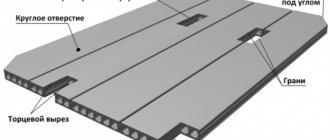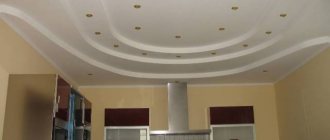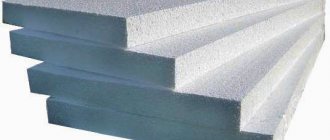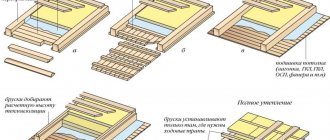Stretch ceilings are one of the most common types of ceiling finishing. A variety of designs, textures, and color shades are the main advantages of this type of coating. They have another remarkable property - moisture resistance and the ability of PVC film ceilings to hold large volumes of water if something bad happened and the neighbors above forgot to turn off the tap.
All that remains is to organize the drainage of water from the stretch ceiling and dry the canvas thoroughly. However, you need to know how to properly eliminate the consequences of a possible “flooding”.
How can water end up on the ceiling?
In addition to sloppy neighbors, there may be several reasons for this phenomenon:
- Penetration of cold water due to a break in the main pipeline.
- Hot water from water supply and heating systems.
- Liquids from the sewer.
- Rain flows entering the room from storm drains or through the attic.
Also, moisture without objective reasons can appear as a result of “dry” leaks in hot weather, when condensation accumulates under the coating.
Important! If cold water gets on the ceiling, it will cause minimal damage to the coating. If hot liquid accumulates, you will most likely have to completely replace the blade. The same applies to sewage drains. In this case, the suspended ceiling will not only be significantly deformed, but will also lose its aesthetic qualities.
The effect of water on a suspended ceiling
The reaction of the tension system to water largely depends on the material used to make the decorative fabric:
- Fabric. They are made on the basis of polyester fibers, which have many tiny pores. Therefore, if there is leakage from above, such a sheet simply begins to leak, and all the water ends up in the room. In addition, polyester has virtually no elasticity. As a result, if the speed of liquid entering from above exceeds the speed of its flow out through micropores, sooner or later the panel breaks or comes out of the fastening profile and falls to the floor.
- PVC film. According to the manufacturers, these fabrics are able to withstand loads of up to 100 kg/m². The duration of the confrontation can be measured from several days to a month. Here everything will depend on the quality of the material and the volume of accumulated water. Liquid retention is favored by the elasticity of the material, which makes it possible to reduce the increased load on the fastening profile by an order of magnitude. As a result, a suspended PVC ceiling after flooding takes on the appearance of a surface with a convexity (pear). Usually this formation is located closer to the center.
Flooded PVC stretch ceiling
If you carry out the water draining procedure correctly, the room will remain completely dry, and the canvas itself will again acquire a functional appearance. It should be noted that effective resistance to water by a tension film is only possible if the flowing liquid is not very hot. The fabric will not be able to hold water at temperatures above +50 degrees for a long time.
How stretch ceilings behave during flooding
Only ceilings made of PVC film can save a room from a huge flood. They stretch almost twice, due to the density of the material, and form a kind of “bubble” that reliably holds water.
Penetrating through the ceiling beams, water begins to flow down the walls and goes inside the ceiling covering. With reliable and high-quality fastening of the stretch ceiling, liquid will collect on the surface of the canvas, pulling it out. At the same time, 1 sq. m. PVC film can hold 100-120 liters.
Fabric stretch ceilings have a porous structure. When moisture gets on them, it quickly seeps through micropores and floods the room. In addition, under the weight of water, the coating may not withstand it, and the canvas will turn out of the baguettes.
Despite the fact that fabric ceilings are seamless, they are able to retain moisture for a very short time and in small volumes.
Therefore, experts recommend not using fabric textures in rooms with high humidity or in rooms where there is a risk of flooding (kitchen, bathroom).
Possible errors when draining water yourself
If you are deciding how to drain water from a suspended ceiling yourself, you need to avoid common mistakes that owners of suspended ceilings make when saving canvases:
- The amount of accumulated liquid was incorrectly estimated, as a result of which there were not enough water containers. Since once it starts, the process will not stop until all the water is drained from the ceiling, it is better to prepare more buckets and basins in advance;
- Do not try to pierce the decorative fabric to drain the water. The high pressure that forms in the bubble under the influence of accumulated liquid will cause the coating to break through. Then you will have to change the PVC film;
- You cannot push water towards a corner or hole under a lamp with your hands. Thus, you can scratch the film or drive water into the far corners of the ceiling, which will create even greater problems when draining. And, if the coating from the inside does not dry completely, mold will form in the ceiling space over time;
- The film web can only be smoothed if you heat the material and the room with a heat gun. Other methods will not help, but will completely ruin the coating.
What to do if the ceiling is flooded with water
At the first sign of water accumulation on the ceiling, you need to take action immediately.
First of all:
- Turn off the power supply at the panel. Before you drain the water from the suspended ceiling, it is better not to use electricity.
- Find the true cause of the appearance of liquid on the coating.
- Try to stop new volumes of water from reaching the ceiling as quickly as possible.
- If your neighbors are the culprits of the flood, immediately notify them so that they turn off their water.
- If the cause of the flood is a break in the sewer system or heating pipes, it is necessary to turn off the water in the basement and call emergency services.
What to do first
If you are flooded, do not rush to try to drain the water from the stretch ceiling. First of all, you need to do the following:
- Turn off the electricity in the apartment. Do this without fail so that you do not get an electric shock. Don't forget that water conducts electricity, so take safety precautions. We also recommend that you turn off all equipment and take it away from the room that is flooded.
- Notify neighbors about the leak. There is no point in trying to get rid of a water bubble from a stretch ceiling at a time when water is still flowing. You need to reach out to your neighbors and let them know about the problem. It could be that they turned on the faucet when they had no water and then forgot to turn it off. Your neighbors may simply not know that they are flooding you.
- Prepare containers for draining water and ask for help. Stock up on several buckets, basins and other containers in advance. You will also need a hose, but if you don’t have one, it’s okay - you can drain the water from the stretch ceiling by simply moving the canvas. This is not the most convenient way, but it can help. We recommend that you ask for help from family, friends or residents of your home. You will ideally need three people: one to drain the water, another to fill the containers, and a third to empty them in a timely manner. If you want, you can do it together, but it’s much more difficult.
Pumping water from a suspended ceiling yourself
Preparation
In case of unexpected flooding, you can call a special company that provides services for eliminating such disasters. If this is not possible, you will have to act independently.
Before draining water from suspended ceilings, you need to prepare:
- Remove all household appliances, furniture and other valuables from the premises.
- Cover the remaining interior items with thick film.
- Prepare basins, buckets and other containers for draining water.
- Find the drain location. This could be a hole located where the lamp is mounted or a corner as close as possible to the largest accumulation of water.
Stretch ceilings draining water, possible errors
The situation is not so critical if the ceiling is flooded in the bathroom or kitchen. In this case, it is enough to stretch the hose and pump the water into the sink. The situation is different with the coating in the rooms.
When a leak occurs, the ceiling sags, making it almost impossible to determine the amount of liquid accumulated there. The denser the material, the larger volumes of water it can hold. In any case, there will be a lot of it. Therefore, it is impossible to do without the help of strangers.
The most common mistake when draining yourself is incorrectly determining the amount of water. Other errors include:
- Puncture the material to drain water.
Important! It is forbidden to pierce the fabric. Even a small hole will increase in diameter under the weight of water and you will have to say goodbye to the suspended ceiling.
- Passing liquid through the canvas to the hole for the lighting fixture.
- Attempts to smooth the canvas using improvised objects.
- Drying the ceiling with a household hairdryer in order to restore its original structure. This can only be done with a gun for installing suspended ceilings or with a construction hairdryer.
First actions in case of flooding
The first thing that owners whose apartment is flooded should do is turn off the power. To do this, unscrew the plugs and turn off the machine in the electrical panel.
Then you need to find neighbors to inform the culprits about the leak and eliminate the source if the cause of the flood is their carelessness. Or shut off the common riser if the owners of the upper apartment have nothing to do with it.
Next, clear the room of furniture that can be removed. Protect other interior items with plastic wrap. Prepare buckets and basins for draining water. The more containers you find, the better. After this, proceed to removing water from the stretch ceiling.
Options for draining water from a stretch ceiling
As mentioned above, you can drain the water in one of two ways.
Through the hole located at the installation site of the lighting fixture
You must proceed as follows:
- Find the lamp located closest to the maximum accumulation of water on the canvas and dismantle it, first turning off the electricity.
- Pull the canvas down by the “hole” from the chandelier until water begins to flow out of it into the placed bucket.
Important! A reinforcing ring is placed over the hole for the lighting fixture to prevent the fabric from spreading. When draining the water and stretching the film, you need to stick your fingers inside the ring and wrap your hands around it in several places.
- Stretch the canvas until the water is completely pumped out of it. If the volume of liquid is too large, the help of a second person is needed to lift the bubble from the middle.
You can use a hose by inserting it into the hole if there is a lot of water collected on the ceiling. This will make it easier to avoid overfilling the bucket with water. It is enough to pinch the outlet end of the hose with your fingers at the moment when another person takes containers of water out of the room.
When the water stops flowing into the bucket, the job is finished. However, there is no need to rush to reinstall the lighting element and turn on the power supply switches. This can only be done after the panel and the entire ceiling surface have completely dried. Typically the waiting period ranges from 2 days to a week.
Through dismantling the baseboard indoors
This method will help if the lighting fixtures are located far from the place of greatest accumulation of water. Necessary:
- Determine the wall section of the structure closest to the maximum sagging of the canvas.
- Remove the required part of the ceiling plinth.
- Carefully remove a small part of the film. The canvas should be held as tightly as possible.
To dismantle the canvas from the fastening, you need to equip yourself with a tool like a screwdriver, the edges of which should be wrapped with soft cloth so as not to pierce the material. Having inserted the tool into the profile groove, you need to bend the bar until the fastening becomes noticeable. Then use pliers to pick up the harpoon and remove it from the profile. For such an “operation” it is enough to dismantle 20 cm of the coating. Now you can start pumping out the water.
- If the volume of water is not too large, it can be poured into a substitute bucket by slowly lowering the edge of the film. For a large amount of liquid, use a hose, as in the first method.
You must act very carefully if the ceiling is flooded with boiling water. Hands must be protected with thermal gloves. And it is better if such work is performed by specialists. You should also turn to them for help when the bubble hangs over the sharp edge of a table or other furniture, threatening to burst at any moment.
Drying the ceiling after draining the water
After the water has been completely drained from the ceiling, it must be thoroughly dried. Otherwise, the appearance and development of mold spores cannot be avoided. It is better if the drying of the cloth is carried out by a specialist using equipment designed for this purpose. Usually the canvas is heated with a heat gun or a hair dryer.
Most often, companies that install stretch ceilings provide a guarantee on the coating. Therefore, you can contact them. They will not only eliminate the consequences of the flood, but will also make a discount on repair work, returning the canvas to its previous appearance.
On a note! Only fabric coverings can restore their original shape and smooth out themselves. If a ceiling made of PVC film is flooded, after completing the rescue work and re-installation, the canvas will remain wrinkled; only a specialist will return the ceiling to its original appearance using a heat gun.
If the flooding was severe, it is necessary to dry the base ceiling, treat it with antiseptic solutions and remove cracked plaster.
In conclusion, it can be noted that flooding of suspended ceilings is not such a terrible disaster. By following certain rules and technologies, it will be possible to eliminate all the consequences of the flood.
Which suspended ceilings retain water well?
If you do not want to repair suspended ceilings after a flood and restore damaged furniture and premises, install only coatings that hold liquid well and do not let it into the room. These are polyvinyl chloride stretch ceilings. A square meter of such coating can withstand up to 100 liters. After a flood, it is enough to simply drain the liquid, dry the ceiling space and slightly stretch the covering, which has stretched from the weight of the water, heating it with a heat gun.
If a suspended ceiling made of fabric is flooded, the material will not hold back the flow of water, but will let it through its pores into the room. Moreover, the surface of the stretch ceiling will become covered with stains and stains from direct contact with water. But if the coating itself can be dried and painted with water-based emulsion to give it an attractive appearance, then the furniture, floors and walls will be hopelessly damaged.











